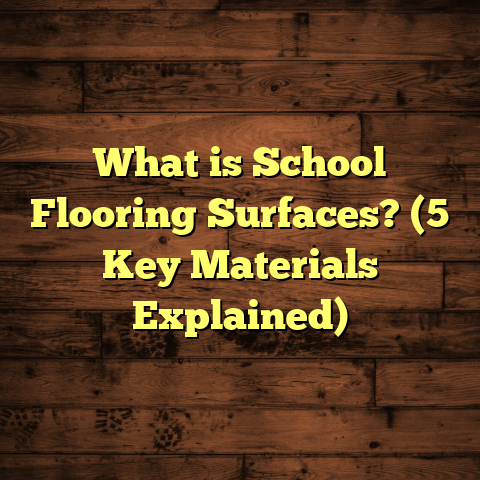What is Engineered Wooden Flooring? (5 Benefits for Homeowners)
Durability is the first thing I bring up when chatting about flooring options. If you’re anything like me, you want something that not only looks good but lasts through daily life’s wear and tear. Over the years, I’ve found engineered wooden flooring to be a standout choice for homeowners who want beauty and resilience rolled into one. It’s a flooring solution that blends real wood’s charm with modern engineering’s practicality.
What Is Engineered Wooden Flooring?
Let’s start by breaking down what engineered wooden flooring actually is. At its core, engineered wood isn’t just one solid piece of timber—it’s a layered system designed to maximize durability and stability without sacrificing the look and feel of natural wood.
Imagine a sandwich: the top layer is a thin slice of real hardwood, called the veneer. Beneath that are several layers of plywood or high-density fiberboard (HDF), glued together with their wood grains running perpendicular to each other. This cross-laminated construction is what gives engineered wood its strength and resistance to swelling or shrinking.
The thickness of that hardwood veneer varies widely. You’ll find options ranging from about 2mm thick on budget-friendly floors to as much as 6mm or more on high-end products. The total plank thickness usually falls between 10mm and 15mm.
How It’s Made
The manufacturing process is quite fascinating. It starts with selecting hardwood logs—oak, maple, walnut, hickory, and more—depending on the desired final look. These logs are sliced or peeled into thin sheets to create the top veneer layer.
Meanwhile, the core layers are prepared using sheets of plywood or HDF. These are glued together under heat and pressure, ensuring each layer’s grain runs at a right angle to the one below it. This cross-grain technique is key; it counters wood’s natural tendency to expand along the grain when exposed to moisture or heat.
Once these layers are bonded, the top hardwood veneer is glued on. The planks are then cut to size and sanded smooth. Finally, manufacturers apply protective finishes—often UV-cured polyurethane or aluminum oxide coatings—to increase scratch resistance and durability.
Why Layers Matter
This layered construction makes engineered wood much more stable than solid hardwood. Solid wood planks react strongly to humidity changes, expanding and contracting along their grain axis. This can cause gaps, cupping, or even cracking over time.
Engineered wood’s cross-laminated core reduces this movement dramatically. When I first learned about this during my flooring training, it changed my perspective on what wood floors could do in tricky environments like basements or kitchens.
To put it in perspective, solid hardwood can expand up to 8-10% in width with moisture changes; engineered wood usually stays under 3%. This means fewer worries about floor damage when seasons change or if you live in a humid climate.
My Journey with Engineered Wooden Flooring: Stories from the Field
Over the years, I’ve installed engineered wooden flooring in all sorts of homes: from cozy bungalows to luxury condos. One project that stands out was a Victorian-era home with old subfloors prone to moisture damage. The homeowners wanted hardwood floors but were concerned about warping—a common problem with solid wood in older houses.
We chose a high-quality engineered oak with a 4mm veneer and plywood core. After installation, the floors stayed perfectly flat for years despite occasional humidity spikes. The family was thrilled not only because of the floor’s beauty but because they didn’t have to worry about costly repairs down the line.
In another case, a young couple renovating their first home wanted the warm look of walnut floors but faced budget constraints. Engineered walnut flooring gave them a rich appearance similar to solid wood at nearly half the cost. Plus, installation was faster since we used a floating method over their existing subfloor.
These experiences taught me that engineered wood isn’t just a cheaper alternative—it’s often a smarter choice suited to modern living conditions.
Five Benefits of Engineered Wooden Flooring for Homeowners
Let’s explore why I recommend engineered wooden flooring so often by diving into five benefits that homeowners value most.
1. Superior Stability in Varying Conditions
Have you ever noticed your hardwood floors developing gaps or buckling after humid summers or dry winters? That’s because solid hardwood naturally absorbs moisture and expands or contracts accordingly.
Engineered wood handles this issue far better thanks to its layered build. Those cross-laminated cores keep planks stable even when humidity fluctuates between 30% and 60%, which is common indoors.
I recall working on a project near the coast where salty air and moisture levels could wreak havoc on floors. We selected engineered flooring specifically designed for coastal climates with an extra-thick plywood core for added stability. Years later, those floors still looked flawless.
According to industry research, engineered wood expands and contracts about one-third as much as solid hardwood under similar conditions, reducing maintenance headaches.
2. Flexible Installation Methods Save Time and Money
One aspect homeowners often overlook is how flooring installation affects their overall renovation timeline and budget.
Engineered wooden floors offer three main installation methods:
- Floating floors: Planks lock together but aren’t nailed or glued down.
- Glue-down: Adhesive bonds planks directly to subfloor.
- Nail-down: Common with wooden subfloors; nails secure planks in place.
This flexibility means you can install engineered floors over concrete slabs, existing vinyl, or even tile—something you generally can’t do with solid hardwood without extensive prep work.
I once installed an engineered floor as a floating system over an old tile floor for a client eager to avoid demolition costs. The project finished two weeks earlier than expected and saved thousands in labor.
3. Authentic Wood Appearance That Lasts
If you love the natural charm of wood grain and texture but worry about laminate looking fake, engineered wood strikes a perfect balance.
Because its top layer is real hardwood—whether oak, maple, cherry, or exotic species—you get genuine color variations, knots, and aging characteristics.
Many engineered floors come prefinished with tough coatings like aluminum oxide that resist scratches better than unfinished solid wood floors finished onsite.
In my own home, I installed engineered hickory with a 3mm veneer finished using UV-cured polyurethane. After four years of kids and pets running around, it still looks fantastic with just routine cleaning.
Plus, if you pick engineered planks with thicker veneers (4-6mm), you can sand and refinish them multiple times — extending their lifespan well beyond 20 years.
4. Cost-Effective Without Sacrificing Quality
Budget questions come up all the time when I discuss flooring options with clients. Engineered wooden flooring often fits nicely between laminate’s affordability and solid hardwood’s premium price tag.
Because only the thin top layer uses expensive hardwood species, manufacturers can offer engineered products at 20-40% lower prices compared to solid wood of similar species and grade.
On average:
- Engineered wood: $5-$12 per square foot
- Solid hardwood: $8-$15+ per square foot
Installation costs also tend to be lower due to simpler prep work and faster installation methods like floating floors.
This balance lets homeowners enjoy real wood aesthetics without stretching their budgets too far—as I saw when helping that young couple choose walnut-engineered flooring for their first home.
5. More Environmentally Friendly Choice
I’m always mindful of recommending eco-conscious options whenever possible. Engineered wooden flooring fits well here since it uses less precious hardwood per plank than solid wood flooring.
The plywood or HDF core layers come from faster-growing trees or recycled materials, reducing pressure on old-growth forests.
Many brands also follow strict sourcing standards such as FSC (Forest Stewardship Council) certification to ensure sustainable forestry practices.
In one recent project for an environmentally aware client, we installed FSC-certified engineered maple flooring. They appreciated knowing their beautiful floors came from responsibly managed forests without sacrificing quality or style.
Technical Deep Dive: The Science Behind Engineered Wood’s Performance
Understanding why engineered wood behaves so differently from solid hardwood requires a closer look at physics and materials science.
Wood is hygroscopic—meaning it absorbs and releases moisture based on surrounding air humidity levels. This causes dimensional changes mostly along the grain direction (lengthwise expansion is minimal).
Solid hardwood planks are susceptible because their entire thickness can swell or shrink unevenly when moisture content changes by just 2-3%.
Engineered flooring combats this by layering thin sheets crosswise:
- Each ply’s grains run perpendicular to adjacent layers.
- This cross-grain arrangement balances internal stresses.
- It significantly reduces net expansion/contraction.
- The plywood core acts like an internal frame stabilizing the surface veneer.
The adhesive used also matters; manufacturers typically use waterproof glues like phenol-formaldehyde resin that maintain bond strength under fluctuating moisture levels.
Additionally, finishes add another protective barrier against spills and wear while enhancing scratch resistance.
Installation Insights: What I’ve Learned Over Time
Installing engineered wooden flooring requires attention to detail but generally has fewer surprises than solid wood installations.
Here are some tips based on my experience:
- Acclimate planks: Let flooring sit in the installation room for at least 48 hours so moisture levels stabilize.
- Subfloor prep: Ensure it’s clean, dry, level (within 3/16” over 10 feet), and structurally sound.
- Expansion gaps: Leave 1/4”–1/2” perimeter space around walls for natural movement.
- Underlayment: Use appropriate soundproofing or moisture barriers depending on subfloor type.
- Floating floors: Lock planks carefully without forcing joints; use spacers for uniform gaps.
- Glue-down: Apply adhesive evenly; follow manufacturer drying times.
- Nail-down: Use correct nail size/type; avoid over-driving nails which can damage planks.
One memorable project involved installing engineered flooring over radiant heat slabs—a setup requiring special adhesive types and acclimation protocols to prevent plank movement due to temperature changes.
Care and Maintenance Tips That Keep Floors Looking Great
Maintaining engineered wooden floors is straightforward but differs slightly from solid hardwood care:
- Sweep or vacuum regularly to remove dirt/grit that can scratch surfaces.
- Mop with damp cloths or recommended cleaners; avoid soaking with water.
- Use felt pads under furniture legs.
- Avoid harsh chemicals or abrasive cleaners.
- Repair minor scratches with touch-up kits matched to finish color.
- For thicker veneers (4mm+), consider professional refinishing every 10-15 years depending on wear.
A family I helped recently found that sticking to these simple habits kept their floors looking pristine even after hosting pets and kids daily.
Data & Statistics That Speak Volumes
I often refer clients to industry data when explaining why engineered wood makes sense:
| Feature | Engineered Wood | Solid Hardwood |
|---|---|---|
| Typical Expansion Rate | ~0.5% – 1% width change | ~3% – 8% width change |
| Moisture Tolerance | Up to 14% moisture content | Around 9%-10% moisture content |
| Average Lifespan | 20-30+ years (refinishable veneer) | 30+ years |
| Installation Speed | 30%-50% faster | Longer prep & installation |
| Cost per Sq Ft | $5-$12 | $8-$15+ |
| Environmental Impact | Lower (less hardwood used) | Higher (solid lumber volume) |
Case Study: Engineered Wood in Historic Renovation
One of my favorite projects was renovating an early 1900s farmhouse that had decades-old subfloors with uneven moisture issues.
The homeowners wanted authentic hardwood floors but feared traditional options would warp or buckle in their damp basement environment.
After assessing moisture levels and structural condition, we specified an engineered oak floor with:
- 5-ply plywood core
- 3.5mm oak veneer
- Aluminum oxide finish for durability
The installation used glue-down over a moisture barrier membrane. Post-installation monitoring showed minimal movement even during heavy rain seasons.
The family was delighted by how the floors stayed flat and gorgeous while maintaining historic charm — all at a fraction of the cost of replacing subfloors or installing solid hardwood with extensive prep work.
Frequently Asked Questions I Hear Often
Q: Can engineered wood be used in bathrooms or kitchens?
A: Yes—but choose products with thicker veneers and waterproof finishes. Avoid standing water exposure; wipe spills immediately.
Q: How many times can I refinish engineered floors?
A: Depends on veneer thickness—around 2mm allows one light sanding; 4mm+ veneers can handle multiple refinishes over decades.
Q: Is engineered flooring noisy?
A: Floating installations can produce slight noise if not paired with soundproof underlayment; glue-down methods are quieter.
Q: Can I install engineered wood over radiant heat?
A: Yes—many products are designed for that purpose but follow manufacturer guidelines carefully regarding acclimation and installation methods.
I hope sharing these insights gives you a clearer picture of why engineered wooden flooring remains one of my top recommendations for anyone wanting durable, beautiful floors without compromises. Whether restoring an old home or upgrading your current space, it offers smart benefits worth considering seriously.
If you want me to help figure out if it fits your specific needs or budget, just ask! I’m always happy to share what I’ve learned firsthand from years on the job.





